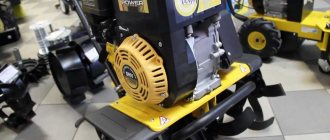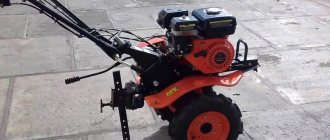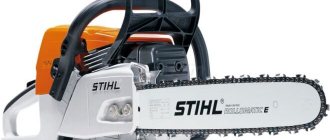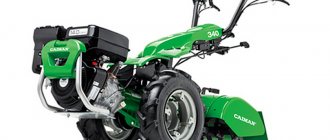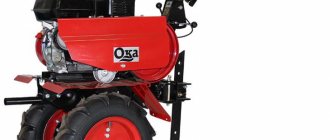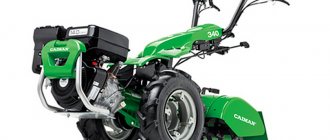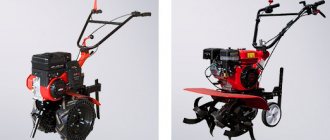Tarpan is a word used to describe the unbridled wild horses that previously lived on our planet. But now the same name is used to designate a series of motor cultivators from a domestic manufacturer. A reliable, powerful engine and high-quality parts inside are not all the advantages that this equipment has. Anyone can study the instructions.
This device has its pros and cons
Design of “Tarpan” units and principle of operation
High-performance equipment was ensured by high-quality assembly of Honda, Champion and Zongshen engines.
Advantages of cultivators:
- Productive worm gearbox.
- The engine is cooled by the air filter, and the carburetor lasts longer.
- Attachments are provided.
- All controls are on the steering wheel.
- The steering wheel is height adjustable.
- Rubber-coated handles make it convenient to change the angle of inclination or turn the cultivator.
- Clutch occurs faster due to reliable spark plugs.
- Separating the cultivator into 2 parts is convenient when transporting in the trunk of a passenger car.
Engine Briggs & Stratton Vanguard OHV 6.5НР 13Н3
Briggs&Stratton Vanguard series gasoline engines are semi-professional single- and two-cylinder air-cooled engines with a horizontal crankshaft, cast iron cylinder liner, and overhead valves (OHV). Model 13N3 is a single-cylinder gasoline engine with a horizontal crankshaft. It is equipped with an Oil-Guard low-oil start-up protection system, which is activated only during engine startup and automatically turns off afterwards, allowing for short-term tilting of the equipment (up to 25 degrees). If the oil level is insufficient, the engine turns off.
The engine design uses a Dual-Clean air filter. This is an automotive-style air filter element made of corrugated paper, with a foam pre-filter, providing double protection for a longer engine life. The cast iron Dura-Bore cylinder liner provides good wear resistance in all operating conditions, along with reduced oil consumption.
Service Features and Operating Instructions
Let's take as a basis the operating rules from the instructions for ≪TMZ-MK 03≫.
Changing the oil in the gearbox
Draining the oil immediately after work makes the procedure easier.
We use oil TAD-17I GOST 23652-79. Replacement with transmission oils of class SAE 90, SAE 75W/90, API categories GL-4, GL-5 with a volume of 0.35 liters is acceptable.
Motor cultivator ≪Tarpan MK-03-02 WM168FB≫
- We change the oil in the gearbox after the first 5 hours of operation of the cultivator.
- Every 5 hours or daily we check the tightness of the connections of engine parts for oil and fuel leaks.
- Every 100 hours or annually we change the oil in the gearbox.
- To check the oil level in the gearbox, it must be drained into a measuring cup and added to a volume of 0.35 liters.
- Oil is drained and refilled into the gearbox through the same hole, which is closed with a plug.
Replacing oil seals
During the warranty period, to repair the breakdown, contact the service center or the manufacturer.
After the warranty period, the service center will replace the oil seal without any problems. But you can do it yourself.
Replacement of the oil seal is necessary in case of oil leakage from the gearbox.
The cultivator is run in during the first 12 hours.
To replace the oil seal yourself:
- clean the gearbox and drain the oil;
- turn the gearbox upside down with the bolts and open the housing;
- Mark with a marker the position of the shaft with gears in relation to the body so that after repair the shaft fits correctly;
- remove the oil seal with the cover from the shaft;
- carefully remove the oil seal, which sits tightly in the cover, with a blunt screwdriver or similar tool, without damaging the cover;
- Place the new oil seal on the cover so that it is in place, place the old one on top of it and tap it with a hammer.
The new one should snap into place until it stops. If a gap remains, this needs to be corrected.
Replace the second oil seal in the same way. Then, lubricate the gearbox halves with sealant and connect them taking into account the marks made earlier with a marker.
Running in and launching the cultivator "Tarpan"
In the first 12 hours there is a break-in. Do not use the unit at full capacity during this period. It is better to go through one section several times.
Before starting, check the oil level, whether gasoline is filled, and whether the power unit and the executive unit are securely connected.
Initially, the clutch lever is free, the gear shift knob is in the neutral position.
The oil level must be checked before starting the cultivator.
To start the engine:
- move the gas control lever to the 1/4 stroke position;
- Pull the cord handle slowly until you feel resistance;
- quickly pull the cable to start the engine and release it slowly, without jerking.
If it doesn't work, try again.
When starting, move the throttle lever to the “MIN” position and warm up the engine. You can start working.
Stopping the engine
To turn off the engine, release the control lever. It will return to the idle position under the action of the return spring. Press the lever all the way and the engine will stop.
Model range overview
Tarpan motor cultivators compare favorably with other similar models due to their unique prefabricated design - the agricultural machine can be conveniently transported to the work site in disassembled form: power unit + gear component.
Modern cultivators are equipped with Honda and Briggs&Stratton engines - reliable, economical, requiring minimal resources for operation. The Tarpan family of motor cultivators also includes models with Chinese Zongshen and Loncin engines, which allows us to produce competitive equipment at budget prices.
Zongshen ZS 168 FB engine Honda GX160 engine Loncin G200F engine Briggs & Stratton RS950 engine
The first Tarpan-01 appeared in 1993. The car was equipped with a two-stroke engine with a power of 6.2 hp. Despite various design flaws, it was quite popular. A few years later, a new modification, Tarpan-03, was developed, which is still in demand today.
Tarpan TMZ-MK-03
The unit is equipped with an American 6 hp motor. with a motor life of 1000 hours. Thanks to the worm gearbox, 1 speed is provided. The cultivator is designed to perform agricultural work on all types of soil. The cutters provide processing of strips with a working width of 35-100 cm.
Cultivator Tarpan TMZ-MK-03
Thanks to its low weight of 45 kg, the machine is very maneuverable. The ergonomic steering wheel can be adjusted to the height of the operator and the length of the handles; it is possible to control the cultivator from the side without trampling the newly plowed area.
Specifications
| Weight, kg | 45 |
| Dimensions (LxWxH), mm | 1300x700x1060 |
| Warranty, months | 36 |
| Cultivation width, cm | 30-70 |
| Engine | Briggs&Stratton I/C 6.0 |
| Oil volume in the gearbox, l | 0,6 |
| Cultivation depth, cm | 20 |
| Number of gears | 1/0 |
| Gearbox | single stage, worm |
| Drive unit | gear |
| Clutch type | dry, automatic, centrifugal |
| Rotation speed of cutters, rpm. | 120 |
| Type | Briggs&Stratton I/C 6.0 with vertical shaft |
| Fuel | petrol |
| Engine displacement, cm3 | 190 |
| Cooling | active air |
| Fuel tank, l | 3,8 |
| Power, hp | 6 |
| Starting system | manual |
Installation of attachments for the Tarpan cultivator
Attachments from different brands are interchangeable.
Mowers
The mower-attachment “String” for “Tarpan” units is designed for mowing grass up to 20 cm. The mower blade successfully copes in open areas and in hard-to-reach places. The rotary mower is no less popular. The attached rake makes it easy to collect hay and use it for its intended purpose.
Snow blowers
The snow removal attachment for the Tarpan cultivator is compatible with equipment from other brands. There is an independent snow blower “Tarpan SNU”, which is controlled manually by levers. Removes snow up to 25 cm high. Processing width 1 meter.
There are many attachments for the Tarpan cultivator
The snow blower can be equipped with a brush, blade, and blades. Capable of throwing snow to the side up to 5 m.
Blade shovel
Using a shovel-mouldboard for the Tarpan cultivator, you can simply rake away debris, level the area, and clear it of snow. Blade rotation is adjustable.
Frame with wheels
Transport wheels attached to the frame make it convenient to move the cultivator.
Hitches
Hitches attach attachments to the cultivator. They can be rotary or U-shaped. Swivel allows you to maneuver while working.
Potato digger and potato planter for the cultivator “Tarpan”
A canopy for planting potatoes looks like a large conical funnel into which planting material is placed.
The most popular potato digger is the screening type. It grabs the root crops along with the soil and, rattling, sifts the contents, leaving the potatoes on the surface of the soil.
Reversible plow
For plowing virgin lands and heavy soils, a reversible plow is used. It is attached to the rear of the unit.
Hillers for soil
Hillers for the Tarpan cultivator come in single-row and disk. Attached without a hitch.
Mills for loosening and plowing
The Tarpan cultivator comes with active cutters designed for loosening the soil. There are also so-called “crow’s feet” - cutters that cultivate the ground instead of a plow. They are purchased additionally or made by craftsmen.
When using a cultivator, it may sometimes be necessary to modify the technique
Lugs
It is difficult to imagine heavy tillage without lugs. The set comes with 2 pieces.
Owner reviews
Dmitry Andreevich, 48 years old
“I acquired this “wild horse” relatively recently (about 3 years ago). At first I suffered a little, the “horse” got caught in a restive manner, and every now and then it tore out of my hands, and I tried my best to hold it. But it’s okay, over time I got the hang of it and now, working with it, I don’t strain myself at all. I plow my 10 acres in 9-10 hours. Fuel consumption is low, I take 92 gasoline and have no problems. No, there was one, after the first winter - the fuel did not drain and the Tarpan did not start. I understood what was going on, drained the old one, poured in the new one, and off we go, the work began in full swing!”
Alexey, 39 years old
“I read reviews and various comments about motor cultivators and decided to buy myself a Tarpan EK-03 cultivator. I was impressed by its environmental friendliness and low noise level. The unit is serious, powerful, and at first it was not easy to hold in your hands. Later I got used to it. And what’s nice is that you don’t have any problems with gasoline, just charge and work! Yes, it has a significant weight, but thanks to this, the immersion of the cutters is impressive! The neighbors are not overjoyed - silence, beauty and the garden is plowed! Of course, I help them. I recently bought a hiller and a potato planter to prepare for the new season. I’ll try to go all out and buy a digging machine by the end of summer. I recommend to all!"
Possible malfunctions and repairs on your own
It is not always possible to contact a service center. Try to eliminate the causes of the breakdown yourself:
- The main problem is that the engine does not start or starts with difficulty. First check if there is fuel in the tank. If there is enough gasoline, but it does not enter the carburetor, you need to press the choke 3 times. Check the spark plug. If necessary, remove carbon deposits from the spark plug, eliminate the gap, or replace with a new one. If the carburetor is clogged, clean it. If the engine speed controller is set incorrectly, read about it in the operating instructions and adjust.
- Another malfunction is that the motor overheats or does not reach maximum speed. Most likely, the air filter or cooling system is clogged. They need to be cleaned. Replace the air filter if necessary.
- If the gearbox output shaft does not rotate while the engine is running, increase speed or check the clutch. The clutch does not work if oil gets on the pads and drums. Wipe them dry if this happens.
- When the gearbox output shaft rotates at engine idle speed, the engine speed may be incorrectly adjusted; The clutch spring may have failed. Adjust the speed according to the operating instructions for the cultivator. Replace the damaged spring.
- If oil leaks from the gearbox, inspect its housing for chips and cracks. Replace the damaged one with a new one. If it’s time to change the sealing collar, follow the advice from the section “Replacing oil seals”.
Refinement of the cultivator "Tarpan"
The need for improvement arises when there are difficulties in using the cultivator. If the unit does not have enough power and it buries itself in the ground; if it is old and it’s time to install modern controls, the owners of the equipment change the design or modify it. At special forums, masters who use the Tarpan technique on their farms exchange opinions and give each other advice to help solve problems.
Specific experience in operating Tarpan walk-behind tractors
Summarizing numerous reviews from owners of Tarpan walk-behind tractors, we can conclude that the equipment is of quite high quality - strong, reliable and durable to use. On the Internet you can find a lot of evidence from those whose Tarpan walk-behind tractor works properly in both the 7th and 8th seasons. The engine starts well under any conditions, is not difficult to maintain, and runs stably. Since it is a four-stroke engine, there is no need to mix oil into gasoline. If there is gasoline left in the fuel tank for the winter, then in the spring you will not be able to start the walk-behind tractor. You need to drain it and fill in a new one, otherwise the engine always starts with half a turn.
There is enough engine power, even with a noticeable excess. Given its light weight, it takes off forward at the start, and when the ground is dry or very dense, it begins to “jump” along it. In this regard, he takes virgin soil with difficulty, or does not take it at all. “If you plow previously cultivated land, then everything goes well. If you try to bite into virgin soil with this device, then “Tarpan” constantly strives to jump out of the arable land and “run away” far forward, without even trying to go deeper, says one of the owners, “in order to get into the virgin soil well, you have to either hang on it all body and press to the ground, or hang heavy metal ballast blocks.” You can feel a lot of fatigue from such intense work, especially when you’re not used to it.
Almost all owners of Tarpan walk-behind tractors complain about the difficult operating conditions during the first plowing: at first, both arms and back get very tired. The back hurts and “falls off”. But once you get used to working with this technique, this goes away. In addition to the strong vibration load and the need to lean on the light walk-behind tractor with your whole body and with serious effort, when working you had to constantly press your thumb on the tight gas handle, and most of all after work it was not only your back that hurt, but also your thumb. True, this problem was corrected on Tarpan walk-behind tractors of recent years of production.
There are descriptions of real experience working on the Tarpan with additional ballast on the Internet. So, one of the owners hung 24 kilogram weights on it; and the other - homemade lead ingots, smelted from the lead of old batteries. With three passes it is still possible to turn dense virgin soil into “fluff”.
Many users of the walk-behind tractor simply remove the casings from the cutters. Considering that they are in the way because grass and roots get wrapped around the cutter blades; stones can get stuck there and bend them. And the covers only block the view, making it difficult to monitor it, and in general contribute to the fact that the cutters become clogged. Closely monitoring the cutters during operation is the second mandatory point of the Tarpan walk-behind tractor maintenance program (along with periodic oil changes). Stones, wire, large roots and stems that wrap around knives can bend and damage them.
According to one of the owners of the Tarpan walk-behind tractor, for seven years in a row, every spring and autumn, he has been using it to cultivate his six acres, plus three more plots of approximately the same size from his neighbors, as “kalym”. During this time, the equipment never failed, there were no breakdowns.
The metal from which the Tarpan walk-behind tractor is made is of noticeably better quality than that of Chinese walk-behind tractors of this class. Especially on Tarpan walk-behind tractors of the first years of production (late 90s / early 2000s). Now the quality of the metal and its coloring, although it has become a little worse, is still at a decent level.
In general, the Tarpan walk-behind tractor can be described as a simple, durable, low-maintenance compact agricultural machinery that is “worth the money.”
Modifications
When a technology manufacturer creates some unique equipment, its work does not end there. If the unit has not been tested by consumers, then it is modified and a new solution is sought that satisfies the needs of the latter.
If the test is successful and you are interested in the unit, it is even more worthwhile to carry out new developments in order to further improve the existing model. This happened with the Tarpan cultivator. The domestic manufacturer offers the following proven modifications:
- Tarpan-03
- Tarpan-031
- Tarpan-04
Fuel consumption by motor cultivator depending on loads
Despite the not very high power of the unit and its modifications, it consumes a significant amount of fuel.
In the process of plowing the soil, the model requires approximately 1.5 liters/hour. This figure may vary depending on the task being performed. Thus, when cultivating hard soils with a plow, the cultivator consumes at least 1.8 liters per hour of operation. When clearing snow, it “eats” at least 2 liters. fuel
However, it is important to take into account that a certain amount of fuel is lost even when the engine warms up.
When hilling potatoes, the cultivator requires, on average, 1.6 liters. fuel, and when working with a rake - about 1.5 l./h. work.
